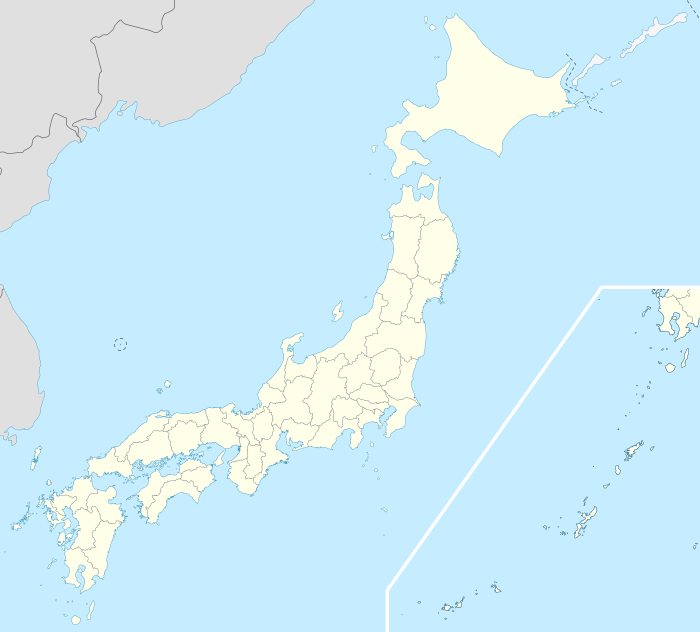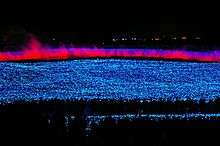Kuwana, Mie
| Kuwana 桑名市 | |||
|---|---|---|---|
| City | |||
|
Kiso Three Rivers and Ise Bay from Mount Tado | |||
| |||
 Location of Kuwana in Mie Prefecture | |||
 Kuwana
| |||
| Coordinates: 35°4′N 136°41′E / 35.067°N 136.683°ECoordinates: 35°4′N 136°41′E / 35.067°N 136.683°E | |||
| Country | Japan | ||
| Region | Kansai | ||
| Prefecture | Mie Prefecture | ||
| Area | |||
| • Total | 136.61 km2 (52.75 sq mi) | ||
| Population (November 2012) | |||
| • Total | 140,796 | ||
| • Density | 1,030/km2 (2,700/sq mi) | ||
| Time zone | Japan Standard Time (UTC+9) | ||
| - Tree | Flowering Dogwood | ||
| - Flower | Japanese iris | ||
| Phone number | 0594-24-1136 | ||
| Address | 2-37 Chūōchō, Kuwana-shi, Mie-ken 511-8601 | ||
| Website |
www | ||

Kuwana (桑名市 Kuwana-shi) is a city located in Mie Prefecture, Japan.
As of November 2012, the city has an estimated population of 140,796 and a population density of 1,030 persons per km². The total area is 136.61 km².
Geography
Kuwana is located in northern Mie Prefecture, facing the Pacific Ocean. It is located at the mouth of Kiso Three Rivers dividing Mie and Aichi Prefectures, the city has functioned as a regional center of fishing, industry, business, and culture.
Neighboring municipalities
- Mie Prefecture
- Aichi Prefecture
- Gifu Prefecture
History
During the late Heian period and Muromachi period, the area of modern Kuwana was known as Juraku-no-tsu (十楽の津) and was a major seaport on the east coast of Japan, controlled by a guild of merchants. The poet Socho described it in 1515 as a major city with over a thousand houses, temples and inns. During the Sengoku period, the area came under the control of the warlord Oda Nobunaga. The Sieges of Nagashima took place in 1571, 1573 and 1574, finally resulting in the destruction of the Ikkō-ikki by Nobunaga’s forces.
After Nobunaga’s death, the area came under the control of Toyotomi Hideyoshi, who initially installed Nobunaga’s younger son Oda Nobukatsu as ruler as all of Ise Province. However, following the Battle of Odawara, Hideyoshi demoted Oda Nobukatsu, divided Ise Province into several domains, was assigned to Ujiie Yukihiro as a 22,000 koku domain in 1595. Ujiie Yukihiro sided with the pro-Toyotomi armies in the Battle of Sekigahara and was dispossessed by Tokugawa Ieyasu.
In January 1601, one of Ieyasu’s main generals, Honda Tadakatsu was installed as daimyō of Kuwana Domain, with revenues of 100,000 koku. The Tokugawa Shogunate recognized the strategic value of the location as both a seaport, and also as Kuwana-juku, as the forty-second post station on the vital Tōkaidō highway connecting Edo with Kyoto. Some travelers along the road would take ships and boats across Ise Bay from Miya-juku (located in present-day Nagoya near Atsuta Shrine) to Kuwana, which reportedly made the journey more enjoyable. The trip across the Ise Bay, which took a whole day, made Kuwana a necessary stop for most of the travelers, benefiting the city's numerous inns and restaurants which served fresh sea food. Kuwana was especially known for its clams.
In 1609, Honda Tadakatsu was succeeded by his son Honda Tadamasa, who distinguished himself at the Siege of Osaka and was rewarded with a transfer to the more lucrative Himeji Domain in 1617.The strategic Kuwana Domain was then assigned to Ieyasu’s half-brother, Hisamatsu Sadakatsu, whose descendants ruled until they were transferred to Takada Domain in Echigo Province in 1710, and their place taken by the Okudaira branch of the Matsudaira clan, who ruled to 1823, when a branch of the Hisamatsu returned to Kuwana from Shirakawa Domain in Mutsu Province. The Hisamatsu continued to rule Kuwana until the end of the Tokugawa shogunate. Matsudaira Sadaaki, the next-to-last daimyō of Kuwana served as the last Kyoto shoshidai and supported his brother, Matsudaira Katamori, daimyo of Aizu Domain. He fought in the Boshin War, finally surrendering to the Meiji government after the fall of the Republic of Ezo.
With the abolition of the han system in July 1871 after the Meiji restoration, Kuwana Domain became “Kuwana Prefecture”, and later became Kuwana District within Mie Prefecture.
The area re-established itself as a regional commercial center and was noted for its metal casting industry. Kuwana Town was established in April 1889. The modern city was founded on April 1, 1937, as a result of a merger between existing towns and villages in the area. The city was devastated by Allied air raids on July 17 and July 24, 1945, during World War II, which destroyed some 90% of its urban area.
Portions of the city were heavily damaged in 1959 by the Isewan Typhoon.
On December 6, 2004, the towns of Nagashima and Tado (both from Kuwana District) were merged into Kuwana.
Today, the city functions as a bed town for nearby Nagoya and Yokkaichi. A large housing estate called Ōyamada (大山田) is located west of central Kuwana.
Transportation
Railway
- JR Central – Kansai Main Line
- Kintetsu – Nagoya Line
- Yōrō Railway – Yōrō Line
- Kuwana - Harima - Shimo-Fukaya - Shimo-Noshiro - Tado
- Sangi Railway – Hokusei Line
- Nishi-Kuwana - Umamichi - Nishibessho - Rengeji - Ariyoshi - Hoshikawa - Nanawa
Highway
- Higashi-Meihan Expressway
- Isewangan Expressway
- Japan National Route 1
- Japan National Route 23
- Japan National Route 258
- Japan National Route 421
Local attractions
Places of interest

- Nagashima Spa Land
- Tado Shrine
- Kiso Sansen National Government Park
- Mount Tado
- Nabana no Sato, famous for its illuminations[1]
 Illumination in Nabana Park
Illumination in Nabana Park
Festivals
Famous products
Sister city relations
-
 Tomamae, Hokkaidō since September, 1981
Tomamae, Hokkaidō since September, 1981 -
 Gyōda, Saitama since November 9, 1998
Gyōda, Saitama since November 9, 1998 -
 Shirakawa, Fukushima since November 9, 1998
Shirakawa, Fukushima since November 9, 1998
Noted people
- Tatsumi Naofumi - samurai, general of the Imperial Japanese Army
- Toshihiko Seko - long-distance runner
- Tsugio Matsuda - racing driver
- Katsuyori Shibata - professional wrestler
- Hirooki Goto - professional wrestler
- Hiroki Shimowada – voice actor
- Mikako Komatsu – voice actress
References
- ↑ "5.8 million Lights illuminate Nabana no Sato theme park in Japan". FarEastGizmos.com. 9 November 2010. Retrieved 5 November 2012.
External links
![]() Media related to Kuwana, Mie at Wikimedia Commons
Media related to Kuwana, Mie at Wikimedia Commons
- Kuwana City official website (Japanese)
- Kuwana-city Tourist guide (Kuwana City) (English)
- Travel brochure (Kuwana City) (English)
- Hiroshige prints of the Tokaido - Station 43 Kuwana (English)